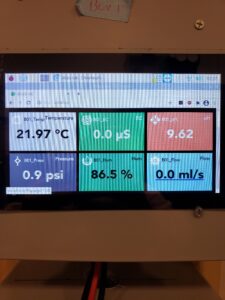Week 1: Learning How to Operate a Dehumidifier
Taara S -
Hey everybody, here is what I have been up to this week!
On Monday, February 12th, I spent several hours working in my professor’s, Dr. Sinha’s, Interdisciplinary Science and Technology Building IV high-bay lab at the ASU Tempe campus. He introduced me to his research assistant, a Master’s student, working on Atmospheric Water Capture for her thesis. The Master’s student walked me through her project’s progress so far and broke down the dehumidifier setup she is using for adsorption of desiccant materials. Her dehumidifier, pictured below, consists of two chambers, a humidifier, a fan, and two sensors.


 <— Fan
<— Fan  <— Sensor one
<— Sensor one  <— Sensor two
<— Sensor twoSpecifically testing beaded orange silica gel, she showed me how to load this desiccant into the compartment between the two chambers and how to take measurements. She let me take a few lines of measurements, in which I noted down on the log sheet the time in minutes since the adsorption process started, the fan voltage speed, the two chambers’ temperature, humidity, pressure, and airflow based on the readings on the two sensors, every five to ten minutes. I then put these measurements into an Excel file and generated a graph that showed the relationship between time (min.) and percent humidity of the two chambers.
The adsorption process took about four hours since we had to wait for the humidity of chamber one to be within ~ 7% of the humidity of chamber two, and stabilize at those humidities for around 20 minutes. After the adsorption process, she walked me through how to remove the desiccant cylinder, which was fascinatingly 3-D printed, and weigh the beads to calculate the desiccant capacity. The orange beads had almost all turned green following adsorption!
The Master’s student also walked me through the setup of desorption. She showed me how to alter the dehumidifier setup, including turning off the humidifier and fan, turning on the transformer, and connecting the heater (pictured below) to chamber 2.

Along with observing and helping with the Master’s student’s experiment, I also discussed with Dr. Sinha what my own experiments would look like. Because the Master’s student is focusing on beaded adsorbents, I will be using the powdered form of those same materials and comparing the sorption kinetics between the two forms. Since crushing the materials into powder increases the surface area, I hypothesize that the powdered desiccants will have faster sorption kinetics and a larger water capacity. I will be testing powdered silica gels as well as other adsorbents such as powdered zeolites, nanoporous sponges, and hydrogels, which I will purchase this week off Amazon or other websites.
I am currently writing my own experimental design/step-by-step process for testing these desiccant materials based on what I learned from the Master’s student’s experiment. For the physical experiment, Dr. Sinha is currently building me an upright, rather than horizontal, module in which I can load powdered desiccants, using a similar setup with a fan and humidifier.
Seeing and understanding the operation of an atmospheric water harvesting set-up in real life and brainstorming how I will conduct experiments over the following weeks is very exciting, and I cannot wait to continue on this journey!

Comments:
All viewpoints are welcome but profane, threatening, disrespectful, or harassing comments will not be tolerated and are subject to moderation up to, and including, full deletion.